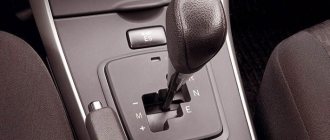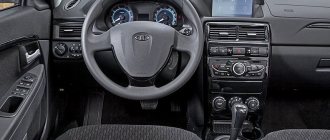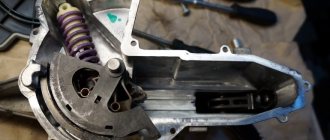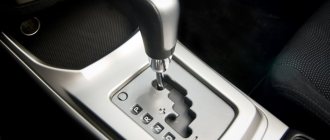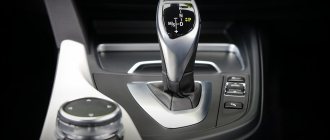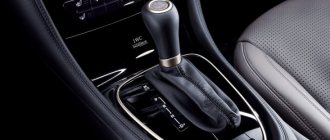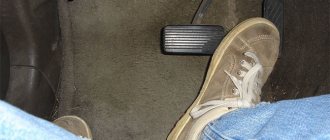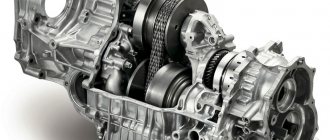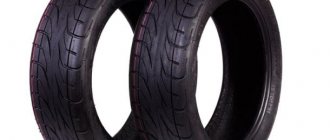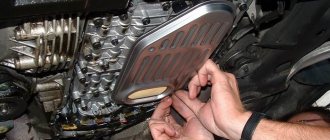In terms of its design features, a robotic gearbox is a manual transmission, with the exception that gear shifts and clutch operation are carried out using an ECU and servomechanisms.
This box has both its pros and cons. The main advantage is fuel efficiency, as well as the relative ease of production of single-disc AMT type robots. As for preselective robotic gearboxes (DSG and analogues), their main advantage is the double clutch, due to which gear changes occur very quickly and unnoticed by the driver.
The disadvantages of both types of robotic gearboxes are very rapid wear of clutch packs, individual actuators, contamination of sensors, souring of contacts, problems with mechatronics, solenoids, etc.
At the same time, repairing and servicing the robot box will not cost the car owner cheap. For this reason, it is necessary to maintain the manual transmission on time and operate the unit correctly. Next, we will look at the features of operation and maintenance of the robot box, and also answer the question of whether the robot box can be towed.
Is it possible to tow a robotic box?
Due to its design features, towing a manual transmission is not recommended, since such a gearbox may fail. Moreover, if for one technical reason or another the car cannot continue moving on its own (for example, towing a DSG is still inevitable), certain rules must be followed during this procedure.
First of all, you should first clarify the information in the repair and operation manual for a particular vehicle. In other words, you need to determine from the manual whether it is possible to tow a particular manual transmission without hanging the drive wheels.
If there is no information, then you should adhere to the basic rules for towing a car with a robot gearbox. Moreover, these rules are actually similar to the requirements regarding towing a car with a conventional hydromechanical automatic transmission or CVT.
To tow you need:
- turn on the ignition and start the vehicle’s internal combustion engine;
- before towing, the gear lever must be moved to the neutral position “N”;
- during towing, the vehicle speed should not exceed 50 km per hour;
- the distance over which a car equipped with a manual transmission is towed should, if possible, not exceed 50 km.
You also need to remember that it is strongly not recommended to tow the robot with the engine turned off (like any other automatic machine). If you do not follow this rule for towing a manual transmission, automatic transmission, or CVT, serious damage to the transmission itself may occur, which requires expensive and complex repairs. So, the car engine must be running when towing. The fact is that when the engine is turned off, the oil pump of the box does not work.
We also recommend reading the article on how to properly tow a car with an automatic transmission. From this article you will learn about the basic rules for towing cars with an automatic transmission or CVT.
Accordingly, oil does not flow to transmission components and mechanisms that require lubrication. As a result, oil starvation occurs on the surfaces of rubbing parts. If the engine does not start for some reason, it is best for the driver of a faulty vehicle to use the services of a tow truck, which will eliminate possible risks.
Let us also add that using a car with a robot gearbox as a tug is also not recommended. This is especially true for complex preselective gearboxes such as DSG. In simple words, if situations arise when it is necessary to tow another vehicle, and the towing vehicle is equipped with a DSG, in this case towing is also undesirable.
However, in extreme cases, you can tow, but you should adhere to the basic recommendations that will allow you to avoid problems with the gearbox in the future:
- the towed vehicle or trailer must not exceed the weight of the vehicle that is towing it;
- you need to switch the manual transmission to manual mode, do not switch to higher gears, do not raise the engine speed above 2/3 of the available ones, but also do not allow driving at low speeds.
- driving should only be at low speed (do not exceed 30-40 km/h) in low gears.
Operating modes
The driver's control of the gearbox comes down to selecting a mode using the selector:
- Neutral is designated "N". In this mode, the engine runs, but no torque is transmitted to the wheels. Turn it on before driving, after stopping, and during long-term parking.
- Forward movement is indicated by "A/M", "E/M" or "D". Having turned on this mode, release the brake pedal and press the gas pedal. The car moves forward, automatically switching gears depending on acceleration or braking.
- Manual control is designated "M". The car moves forward, the driver independently changes gears by pressing the steering wheel paddles or selector to the “+” or “-” positions. In this case, the switching occurs only by one stage.
- Reverse movement is indicated by “R”. By selecting this mode, you can drive backwards.
- Some manual transmissions may have “winter” and “sport” modes.
The concept of a robotic gearbox.
There are also some peculiarities when driving, which the driver must get used to, otherwise he will end up in unpleasant situations.
This is the following:
- Driving in automatic mode requires roads with good hard surfaces. If you drive into mud in the summer and deep, loose snow in the winter, you run the risk of stalling. The algorithm will begin to issue erroneous commands, and transmissions will not be switched on correctly. Such situations increase the wear of parts and mechanisms, which increases the risk of breakdowns.
- The gas pedal must be pressed smoothly; under no circumstances should it be pressed to the floor. It is necessary to monitor the engine speed, recording the moments of gear shifting, and avoid over-throttle.
- If your car does not have a hill start assist function, you need to do the same as when using a manual transmission - use the parking brake to prevent rolling back.
- When stopping for long periods (more than 60 seconds) at a red light or in a traffic jam, you need to switch the selector to the “neutral” position.
- For a long stop in a parking lot, first move the selector to “neutral”, then turn on the parking brake, then release the brake pedal and turn off the engine.
- Each manufacturer indicates how often the ECU needs to be recalibrated based on mileage (also called initialization or training). This must be done due to wear on the clutch disc. The procedure should be carried out every 10,000-15,000 km.
- In winter, at low air temperatures, warming up the box takes exactly as long as it takes to warm up the engine.
Traffic rules requirements
The issue of towing another car with an automatic transmission, as with towing using a manual transmission, is regulated by current legislation. In accordance with the traffic rules, towing is possible only if a number of certain requirements are met, which can be refreshed by studying section “20” of the traffic rules.
In accordance with traffic regulations:
1. A driver must be present at the wheel of a car that is being towed, except in cases where towing is carried out using a rigid coupling and in a straight line.
2. If you happen to be, which is of course unlikely, towing a bus, trolleybus or truck, then you cannot transport passengers in its cabin - they should move to you.
3. It is necessary to clearly ensure the distance between the towed and the towing person - 4-6 meters when moving on a flexible hitch and less than 4 on a rigid one. Also, the flexible coupling must have a special color marking.
4. It is prohibited to tow vehicles that do not have steering or braking systems, as well as two or more vehicles. Moreover, a car with a non-working steering wheel and brakes is still allowed to be towed using the partial loading method, but if you own a passenger car or a jeep, then you most likely will not have to resort to this method of transportation.
5. Drivers of two-wheeled motorcycles without trailers are also not allowed to tow.
The list of requirements is exhaustive, and violation entails administrative liability and a fine.
To avoid ending up in an unpleasant situation, we recommend that you always carry a copy of the current traffic regulations in your glove compartment so that you can make sure that when providing roadside assistance, you are not breaking the letter of the law.
In any case, we believe that if you have the opportunity to provide roadside assistance without damaging your car or breaking the law, you should definitely do so. If you refuse, then perhaps at the moment when you yourself need the support of passing cars - no one will stop.
DSG adaptation
Adaptation is a procedure for adjusting the operation of the gearbox and mechatronics unit, which is necessary after repairs and in some cases when the gearbox is not working correctly. The procedure is simple and can be done with your own hands. Usually adaptation is carried out through Vag Com. Vag Com is a diagnostic program that will allow you to “make friends” of a car with a computer, diagnose and configure some systems. The program has a simple and intuitive interface, it takes up little disk space and it has its advantages compared to its analogues. To ensure the adaptation is carried out correctly, follow this algorithm:
— The box is in position P and heated to 30–100 degrees C;
— The engine is started;
— The brake pedal is pressed during the entire procedure.
If all conditions are met, you need to connect Vag Com. The adaptation is done as follows:
DSG robotic transmission selector
- In the program interface we find the item Basic automatic transmission settings.
- Select the Gear Clutch Settings item and click “Go!” The box will begin to make sounds, and the numbers in the program will change. You need to wait until this stops.
- Select the Gear Shift Points item and click Go. Similar to point 2, we wait.
- Select the Clutch Adaptation item, the actions are similar to point 2. Then we do everything the same way as point 2.
- Item Basic settings.
- Item Pressure adaptation.
- Item With gear shift paddles installed.
- Item ESP and Cruise.
- Click Done.
- Turn off the ignition.
- We wait a few seconds.
- Turn on the ignition.
- We look for errors and remove them if necessary.
- We exit the controller.
- Without using cruise control, we perform a test drive.
- Quit them Vag Com. Adaptation is complete.
Replacing the mechatronics unit will require new firmware. Fortunately, this is easy to do. The mechatronics DSG 6 and mechatronics DSG 7 control units can be easily reflashed using this program.
Sources
- JSC "Arguments and Facts" https://aif.ru/auto/about/zachem_avtomaticheskim_korobkam_rezhimy_l_2_i_3
- Club of fans of minibuses and minivans https://mikrob.ru/viewtopic.php?p=860448#p860448
- Forum “City of Masters” https://mastergrad.com/forums/t77786-buksirovka-pricepa-avtomobilem-s-akpp/
- Yandex.Q https://yandex.ru/q/question/transport/mozhno_li_buksirovat_pritsep_na_toiote_ebc9c710/
- ↑1 2Drive2.ru https://www.drive2.ru/c/543177986648571956/
- ↑1 2 3IZHLIFE https://izhlife.ru/cars/69700-korobka-avtomat-mozhno-li-tormozit-dvigatelem-i-buksirovat-otvechaem-na-voprosy-izhevchan.html
- Yandex.Zen https://zen.yandex.ru/media/auto_moto_velo_foto/opasna-li-dlia-variatora-buksirovka-pricepa-5ed7a8754965f54ee78c510f
- Volkswagen Passat B6 club - Club of Volkswagen Passat B6 lovers https://b6club.ru/viewtopic.php?f=11&t=26921
- Rostov Autoforum https://www.auto-rostov.ru/index.php?showtopic=98604
- Drive2.ru https://www.drive2.ru/c/492270048526729284/
- Wikipedia https://ru.wikipedia.org/wiki/%D0%90%D0%B2%D1%82%D0%BE%D0%BC%D0%B0%D1%82%D0%B8%D1%87% D0%B5%D1%81%D0%BA%D0%B0%D1%8F_%D0%BA%D0%BE%D1%80%D0%BE%D0%B1%D0%BA%D0%B0_%D0% BF%D0%B5%D1%80%D0%B5%D0%B4%D0%B0%D1%87
- Wikipedia https://ru.wikipedia.org/wiki/%D0%A0%D0%BE%D0%B1%D0%BE%D1%82%D0%B8%D0%B7%D0%B8%D1%80% D0%BE%D0%B2%D0%B0%D0%BD%D0%BD%D0%B0%D1%8F_%D0%BA%D0%BE%D1%80%D0%BE%D0%B1%D0% BA%D0%B0_%D0%BF%D0%B5%D1%80%D0%B5%D0%BA%D0%BB%D1%8E%D1%87%D0%B5%D0%BD%D0%B8% D1%8F_%D0%BF%D0%B5%D1%80%D0%B5%D0%B4%D0%B0%D1%87
- https://vector-trailer.ru/stati/kak-ezdit-s-pricapom-na-avtomate-pravila-bezopastnogo-bojdeniya/
- ↑1 2 3 4 5 Hyundai Solaris Operation Manual https://www.hyundai.ru/storage/manual/1582725233.pdf
- ↑1 2 3 Honda CR-V Operation Manual https://auto.honda.ru/docs/
- Nissan Qashqai Operation Manual https://oldk.nissan-moscow.ru/upload/pdf/J11_OM14E-0J11E0E_ru.pdf
- Skoda Kodiaq Operating Manual https://183024.selcdn.ru/skoda/pdf_manuals/kodiaq/A_SUV_Kodiaq_OwnersManual_2019-11.pdf
- Skoda Octavia Operation Manual https://ws.skoda-auto.com/OwnersManualService/Data/ru/Octavia_5E/11-2012/Manual/Octavia/A7_Octavia_OwnersManual.pdf
- ↑1 2 3 Renault Duster Operation Manual https://renault-automir.ru/Duster_manual.pdf
Project manager: Kalimov Alexander Andreevich
Editor and proofreader: Eleonora Arney
Is it possible to push the car?
A car with a manual transmission can be pulled or pushed with the transmission in neutral over almost any distance without problems, since only one gear rotates during this movement. … Thus, it is best to tow the vehicle with the engine running.
Interesting materials:
At what age do historians think Pharaoh Tutankhamun died? At what age does vision deteriorate? At what age were you crucified? At what age should male rabbits be housed? At what age does stubble grow? At what age do Yorkies lose their teeth? At what age did Alan Rickman die? At what age did Lil Peep die? At what age did Zadornov die? At what age should you hang your mobile phone on your crib?
Reviews from car owners
Most motorists speak well of the Raptor paint. The specificity of the issue plays a role here. Repainting the body is an expensive undertaking. And if you take into account that you will have to paint in an unusual format, instead of car enamel, blowing the entire body into polymer, then it becomes clear: before making such a decision, car owners thoroughly study the issue and do not do this work “at random.”
This paint gets good reviews mainly for its really high resistance to external influences. Foresters, hunters and fishermen who drive their vehicles through forests and off-road have appreciated the ability of Raptor coatings to withstand abrasive dirt, stones and tree branches.
Negative reviews of Raptor paints often include motorists' dissatisfaction with local peeling of the coating and the impossibility of spot repairs with an acceptable result. This problem is especially relevant for plastic elements. It happens that almost half of the coating falls off from a bumper or molding at one time.
Typically, motorists with an adventurous streak decide to undertake such experiments. Those who are not afraid to try new things. Those who try, for example, “Titan” paints or protective compounds like “Bronekor”. And often such experiments end in positive emotions.
The choice of paints on the automotive market is simply huge, they are all different colors and most of them provide a beautiful glossy surface. But the issue of visual beauty when using SUVs is at a secondary level, and the main thing is reliability, resistance to mechanical stress, dirt and moisture. Glossy surfaces, often with the first serious scratches, immediately form chips, on which the surface begins to rust and loses its appearance. Owners of SUVs, both domestic ones like Niva, UAZ, and imported ones: Jeep, Toyota, Mitsubishi and others, who are hunters, fishermen or lovers of outdoor activities, are looking for options for updating the factory paintwork to a new, more reliable one.
Painting a car with raptor solves this problem. We will consider materials from U-POL. The Raptor material from this company is sold as part of the polyurethane coating itself and additional consumables in the form of a hardener. One of the important points is that you can apply this material to the car body with your own hands, right in your garage. The technology is quite simple and accessible to everyone.
Towing a car with automatic transmission
With such a box everything is much heavier. Surely everyone has heard that towing a vehicle with a manual transmission and an automatic one are two different things. But not everyone can tell you what to do correctly. Often in such a situation, car owners doubt that their car will be able to tow another vehicle. And how to do everything right. If mechanics are installed, then only one gear rotates in neutral gear. On an automatic transmission, the opposite is true: all possible gears rotate.
Such a box is not designed for such overloads, which can lead to overheating of the part or its breakage. The gearbox is lubricated by oil, which pumps the oil pump while the engine is running. But when the engine is turned off or faulty, then the gearbox will not be lubricated. Because of this, it may fail. But what about towing? If a vehicle with an automatic transmission is pulled by another car, then the unit experiences enormous overloads. The automatic is not designed for such driving. He demands more leniency.
